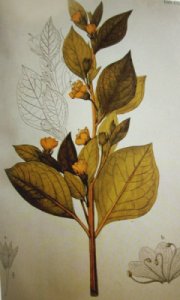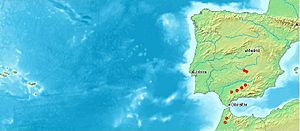Andalusian belladonna facts for kids
Quick facts for kids Andalusian belladonna |
|
|---|---|
 |
|
| Scientific classification | |
| Genus: |
Atropa
|
| Species: |
baetica
|
 |
|
| Distribution | |
The Andalusian belladonna (Atropa baetica) is one of Europe's rarest wildflowers. It is a close relative of the well-known deadly nightshade (Atropa belladonna). Its scientific name, baetica, comes from an old Roman province in Spain. The common name, Andalusian belladonna, refers to the Andalucía region in southern Spain, where it is most often found.
This plant is a pretty perennial herbaceous plant, meaning it lives for many years and has soft stems. It has yellow or greenish funnel-shaped flowers and shiny, black berries. Like other Atropa species, it is very poisonous. It contains special chemicals called tropane alkaloids. These chemicals can affect the body in many ways, like changing how your eyes react to light. Most of these plants grow in Spain. However, you can also find them in parts of Morocco and Algeria in the Atlas Mountains of North Africa. The areas where it grows are known for having many unique plant species.
Contents
What it Looks Like
The Andalusian belladonna is a yellowish-green plant. It has upright, fleshy stems that can grow up to 125 centimeters (about 4 feet) tall. Its leaves are crowded together, oval-shaped, and can be up to 13 by 7 centimeters.
The plant produces single flowers in July. These flowers are funnel-shaped and can be up to 25 millimeters wide. They are green to yellow. After flowering, the plant produces round, shiny, black berries about 10 millimeters wide. The roots grow close to the surface, usually only 10–20 centimeters deep. They often spread out to form a large clump. This plant likes to grow in the light shade of forests on rocky, chalky ground.
Where it Grows
The Andalusian belladonna prefers limestone mountains. It is mainly found in the south and southeast of Spain and Northwest Africa. In Spain, it has been seen in many provinces like Cádiz (province), Province of Málaga, province of Granada, Province of Almería, Province of Jaén (Spain), Province of Cuenca, Province of Guadalajara, Region of Murcia, and Catalonia. It also grows in the Tanger-Tetouan-Al Hoceima region of Morocco and northern Algeria.
Plant Hybrids
Sometimes, the Andalusian belladonna can mix with deadly nightshade (A. belladonna) to create a new plant called A. x martiana. This happens in areas where both plants grow together naturally, like in the province of Jaén, Spain. It can also happen when humans plant them close to each other.
These hybrid plants look like a mix of both parent species. The first A. x martiana was found in a botanic garden in Barcelona. A famous scientist, Professor Pius Font i Quer, described this hybrid. He also started the garden where he found it.
People have also helped spread Atropa baetica seeds in some areas. For example, in 1936, people collecting medicinal plants sowed seeds in the Serrania de Cuenca. They did this to help new plants grow after they harvested the old ones.
How it Compares to Deadly Nightshade
It's easiest to tell Atropa baetica apart from A. belladonna when they are flowering or fruiting.
- A. baetica has open, cup-like, yellow flowers.
- A. belladonna has darker, purple, bell-shaped flowers.
- The shiny black berries of A. baetica are slightly smaller and have fewer seeds. However, its seeds are larger than those of A. belladonna.
- When not flowering or fruiting, A. baetica has yellowish-green leaves and is smoother.
- A. belladonna has darker green leaves and is a bit hairy.
- A. baetica is also a smaller plant, usually not taller than 125 cm (4 feet). A. belladonna often reaches 150 cm (5 feet) or even 200 cm (6.5 feet).
Remember, both plants have very dangerous berries, especially for children.
Where it Lives
Atropa baetica grows in the undergrowth of mixed forests in high areas. It likes dry, sunny, rocky slopes with Calcium-rich soils. Sometimes, it can also be found in shadier, wetter places near streams. It prefers areas that have been disturbed in the past, like the edges of old paths or forest clearings.
It often grows with certain trees like Pinus nigra (black pine), Abies pinsapo (Spanish fir), and Juniperus communis (common juniper). Other plants often found nearby include hawthorn (Crataegus monogyna), boxwood (Buxus sempervirens), and various shrubs and grasses.
Life Cycle of the Plant
The Andalusian belladonna has a short growing season, about five months long. It prefers places with heavy snowfall in winter and hot summers.
- Green shoots start to appear in mid-May.
- The stems grow very quickly, reaching full height in just 3–4 weeks.
- Flowers appear from late June to mid-August, with most blooming in early July.
- Unripe berries can be seen from late June to late September.
- Ripe berries are present from early September to mid-October.
- The plant starts to die back in September and October. By mid-October, most plants have lost their leaves. The last parts disappear after the first rains or heavy snow.
Who Pollinates It
The main insects that visit Atropa baetica flowers are bumblebees (like Bombus lucorum and Bombus pascuorum) and the European honeybee (Apis mellifera). All of these are types of bees.
Other pollinators include different kinds of bees, such as:
- Anthidium septemdentatum
- Megachile octosignata
- Megachile lagopoda
- Anthophora albigena
- Various Ceratina species
- Halictus scabiosae
- Lasioglossum albocinctum
Ants, like Lasius niger, also help with pollination.
Insects That Eat It
The larva (caterpillar) of the moth Heliothis peltigera eats Atropa baetica. However, the plant's leaves are so toxic that the adult moths can have problems, like deformed wings, if they ate the plant as larvae.
Several types of Hemiptera (true bugs) also feed on the juice of the berries, both ripe and unripe. These include Spilostethus pandurus and Carpocoris mediterraneus. Less often, Corizus hyoscyami and Palomena prasina drink the juice of ripe berries. Very rarely, Camptopus lateralis feeds on the sap of the leaves.
The flea beetle Epitrix atropae is named after Atropa plants because it feeds on them. It chews many tiny holes in the leaves.
Birds That Eat It
Like many plants with juicy, sweet berries, A. baetica relies on birds to spread its seeds. Birds eat the berries and then carry the seeds far away in their droppings. The acids in the birds' stomachs help the seeds sprout faster. The droppings also provide fertilizer for the new seedlings.
Since A. baetica berries look very similar to A. belladonna berries, it's likely that the same bird species spread both. One bird known to spread A. belladonna seeds is the song thrush (Turdus philomelos). Other thrushes in Spain probably help too.
Some game birds, like the common pheasant (Phasianus colchicus), can also eat Atropa belladonna berries without harm. So, they probably eat Atropa baetica berries too. Chickens, which are related to pheasants, can also eat these berries.
Mammals That Eat It
Most animals do not eat A. baetica when it is young. However, in September, when the plant's toxic chemicals start to decrease, it is often eaten by the Southeastern Spanish ibex (Capra pyrenaica). These ibexes can strip the plant almost bare of leaves, fruit, and even stem tips. The ibexes do not seem to get sick from eating the plant, even though it is very toxic to humans. This shows that different animals react differently to poisons. For example, as few as two ripe berries of the related Atropa belladonna can be deadly to a child.
There hasn't been much research on whether the Spanish ibex helps spread Atropa baetica seeds through its droppings.
Other animals that cause damage by eating the plant include the mouflon (Ovis orientalis ssp. musimon) and the fallow deer (Dama dama). These are not native to Spain.
Sometimes, feral pigs or wild boars might also damage the plant. However, some experts note that wild boars usually avoid digging up the plant's roots, possibly because they know the roots are toxic. Wild boars can eat plants that are very poisonous to humans, like Aconitum.
Past Medicinal Uses
Like its more famous relative, deadly nightshade, A. baetica was once gathered from the wild for medicine. It was a source of important chemicals called tropane alkaloids, such as Atropine and Scopolamine. Harvesting the roots and stems meant destroying the mature plants. This was a problem because the plant was already very rare. Because of these conservation concerns, it is no longer used in modern medicine.
However, Atropa baetica has also been used in traditional medicine in Morocco.
Plant Chemistry
Scientists have found at least 15 different tropane alkaloids in Atropa baetica. The most common ones are atropine and scopolamine. These chemicals are often found in poisonous plants in the Solanaceae family. They have been used in traditional medicine as pain relievers and anesthetics.
How it Got its Name
The scientific name Atropa baetica was given by the German botanist Heinrich Moritz Willkomm in 1852. He was a pioneer in plant hunting in Spain.
The common name 'Andalusian belladonna' is a direct translation of its Latin name. It connects the plant to its well-known relative, A. belladonna, which is much more common across Europe.
In Spanish, the most common name for Atropa baetica is tabaco gordo, meaning 'stout/big tobacco'. This name links the plant not to other Atropa species, but to plants in the Nicotiana genus, which includes tobacco. Other Spanish common names include:
- tabaco de pastor ('shepherd's tobacco')
- tabaco Filipino ('Filipino tobacco')
- tabaco verde ('green tobacco')
- tabaco borde ('wayside tobacco')
These names suggest that people in Spain might have sometimes smoked A. baetica like tobacco. It also shows that people noticed a family resemblance, especially in the leaves, between Atropa and Nicotiana. Interestingly, the less common but stronger tobacco plant, Nicotiana rustica, has yellow flowers, just like Atropa baetica.

